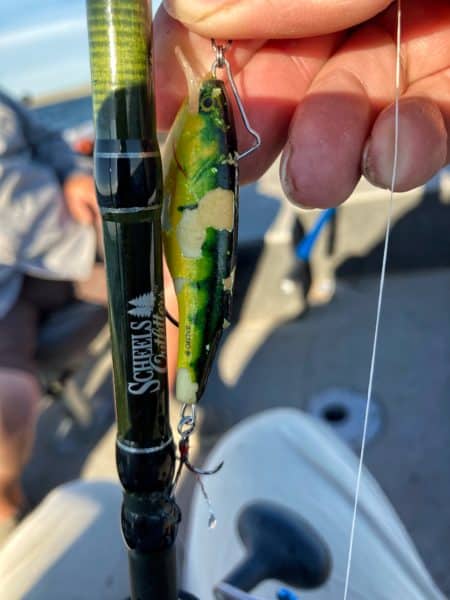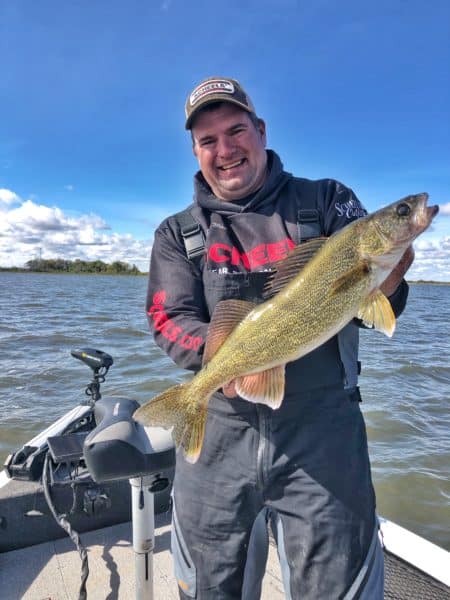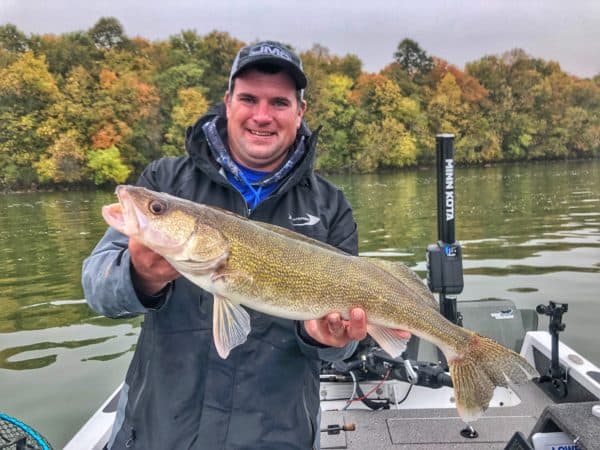Fall Walleye on The Rocks
Category: article
Sep 5th, 2020 by Keith Worrall
Modified Sep 5th, 2020 at 10:29 AM
Fall Walleye on the Rocks
By Jason Mitchell
Big boulders and rock locations can hold walleye through the year but on so many different fisheries, these locations seem even more appealing in the fall. Boulders in deep water (that might range from fifteen to forty feet of water) are especially productive. Deep structural elements like points or main lake reefs often hold fish and rocks or boulders seem to make these locations even better. As a rule of thumb, any rock is better than no rock come late fall but boulders that range from two to four feet in diameter are often big fish locations.
Fishing these rock locations is often a spot on the spot affair. The entire reef might be covered with some type of rock for example but we find that we catch more and bigger fish by picking these locations apart and analyzing them. Finding the sweet spots is often all about finding the right rocks. What we find on some northern Minnesota and Canadian Shield lakes is that some humps or high points on a contour map might simply be one enormous mass of rock that might be fifteen feet across or more. That isn’t what we are looking for. The best rocks might be on the outer edges of a chunk of rock that seems to be the size of a one car garage. Other locations might be covered with small rocks that are the size of a bowling ball or smaller and on one piece of the structure are the boulders as described above. The round rock that is the size of your desk. These types of boulders offer a lot of crevices and character. The sweet spots are often gaps or spaces in between the boulders or edges where boulders meet small rock, sand or even mud.
You have to pick your way through this type of structure. You are going to get snagged and you must pay your dues figuring out these locations. Fish can also get lost in the bottom where it can become difficult to always mark fish. Side imaging can be a useful tool for gauging the bottom composition. I personally believe down view reveals fish the best in these types of locations and it becomes easier to distinguish fish from rock when the fish are not separating from the bottom but fish can show up on traditional 2D sonar particularly when fish are separating from the rocks. When fish do separate from the rock, these fish are typically aggressive but the bottom line is that it is easy to miss fish with your electronics when fish are hiding in crevices and blind spots. Lowrance has a feature called Fish Reveal that combines Down View with traditional 2D Chirp sonar that is helpful for finding fish laying low but there comes a point when you just have to fish through good locations without always marking individual fish when fishing boulders.
You might have to slow down and fish the entire location to pin point the spot on the spot but once you get a few way points, I still find that a marker buoy is extremely helpful for pin point boat control. Because snagging is an issue, the key across the board is often simply fishing as vertically as possible. Prominent presentations include classic vertical jigging with either live bait like a chub or big minnow or soft plastics like a fluke tail. Live bait rigging big creek chubs is a classic fall presentation that accounts for so many big fish on a lot of different fisheries. Snap jigging horizontal swim lures like Rail Shads, Tikka Minos or Jigging Raps can also be extremely productive. The key with all these presentations is pinpoint boat control and a vertical presentation. Move the boat in increments and hover. In wind, I still love to back troll with a tiller but spot lock capabilities on many trolling motors have made boat control easier. Get straight up and down to feel your way through the rock.
Must have pieces of equipment that are cheap and worth their weight in gold include a classic marker buoy but also have a hook file in the boat for keeping a point on hooks. You will be folding over the points on hooks nonstop. Some people like thin wire hooks on jigs just for bending out the hook on snags. The challenge with a premium hook point is that they do bend over easier on rock. Expensive hooks aren’t very durable. Despite that downfall, I still would rather use a stiffer wire on a hook and a premium hook point as I feel that I loose fewer big fish when the hook doesn’t bend. Compromises. I simply go through more hooks and touch up the hook as much as needed with a hook file.

For deeper water over twenty feet, I love to use tungsten and feel that the advantages outweigh the expense. Whether I am using an egg weight to hold down a creek chub or a jig, tungsten is louder when you make sporadic bottom contact and besides the weight advantage of keeping your presentation vertical and in the cone angle of your electronics, I truly believe the added noise gets more bites. The Clam Pro Tackle Drop Tg Jig is ideal as this jig is built with a heavy pure grade tungsten and has a long shank premium hook. In many places where I fish, I have a hard time finding good minnows late in the fall so I like the long shank hook for doubling up minnows. Thread one small minnow onto the hook and nose hook a second minnow to bulk up the package. You can also bulk up with a soft plastic and add a small minnow on the back.
When rigging big chubs, don’t be afraid to experiment with the leader length. Many anglers typically like to keep chubs on a short leash just to keep these athletic baitfish close to the bottom but there are simply times when you must go with a longer snell to keep out of snags. I like to start out with a larger size #1 or #2 wide gap octopus or Kahle hook on a twelve-pound mono snell and range my snell between two to six feet. On some tough bites especially in clear water, I feel that I get more bites at times by dropping down to a snell as light as six-pound test. When you must use longer snells with chubs, clip off the tails and back fins with a line clipper so the chub doesn’t have so much horsepower. I find that I get the best action and durability if I run the hook just through the top lip. On big chubs, don’t be afraid to run a small treble off the back of the snell like a stinger hook if you are missing fish. Once you get dialed into the location, you simply hold the weight off the bottom and vertical below the boat where you are not dragging the weight on the bottom. Scoot forward ten feet and stop as you pick your way through the rocks. You typically know when you are about to get hit because the chub goes ballistic.

Over the past ten years, jigging horizontal swim lures has become extremely popular. These lures typically shine with an aggressive snap and cadence. What continues to amaze me is just how hard fish will hit these lures. A reaction strike that sometimes saves some days like turning on a light switch when other presentations simply don’t get bit. If I miss fish or just getting soft bites and am getting frustrated with a spot, I always try to throw a Rail Shad or Jigging Rap down before I pull my hair out and leave. It is surprising how often this presentation can turn a day around. The fish are just there when you snap the rod tip back up. As you can imagine, rock is hard on these lures with broken fins. The Salmo Rail Shad is durable with a polycarbonate fin and has a wicked vibration that more resembles a crankbait. Clam Pro Tackle has a new lure called the Tikka Mino that is a solid construction zinc alloy that also features an exceptionally durable zinc bill. The key with all these lures is the cadence. After working these lures all day, I typically have blisters on my fingers. That is how hard I snap these lures to get them to work.
These rock patterns often produce big fish for us and fall is often a prime time to fish these locations. While the general locations might not be a secret, the spot on the spot often takes some sleuth work to dial in. Some anglers get deterred by the snags and lost tackle but if you understand exactly where to fish with some of these methodical vertical approaches, these locations become less intimidating and less frustrating.
Captions for photos
IMG_3016: Fishing often just gets better in the fall. Deep rock and boulder locations are classic fall
walleye producers with serious big fish potential.
IMG_4148: Fishing rocks effectively is often all about boat control and spot on the spot location.
Vertical presentations often shine because of the snags.
IMG_6552: Snap-jigging high-action baits like the Salmo Rail Shad can be extremely effective. Catching
fish with this type of presentation is all about the stroke and cadence.
